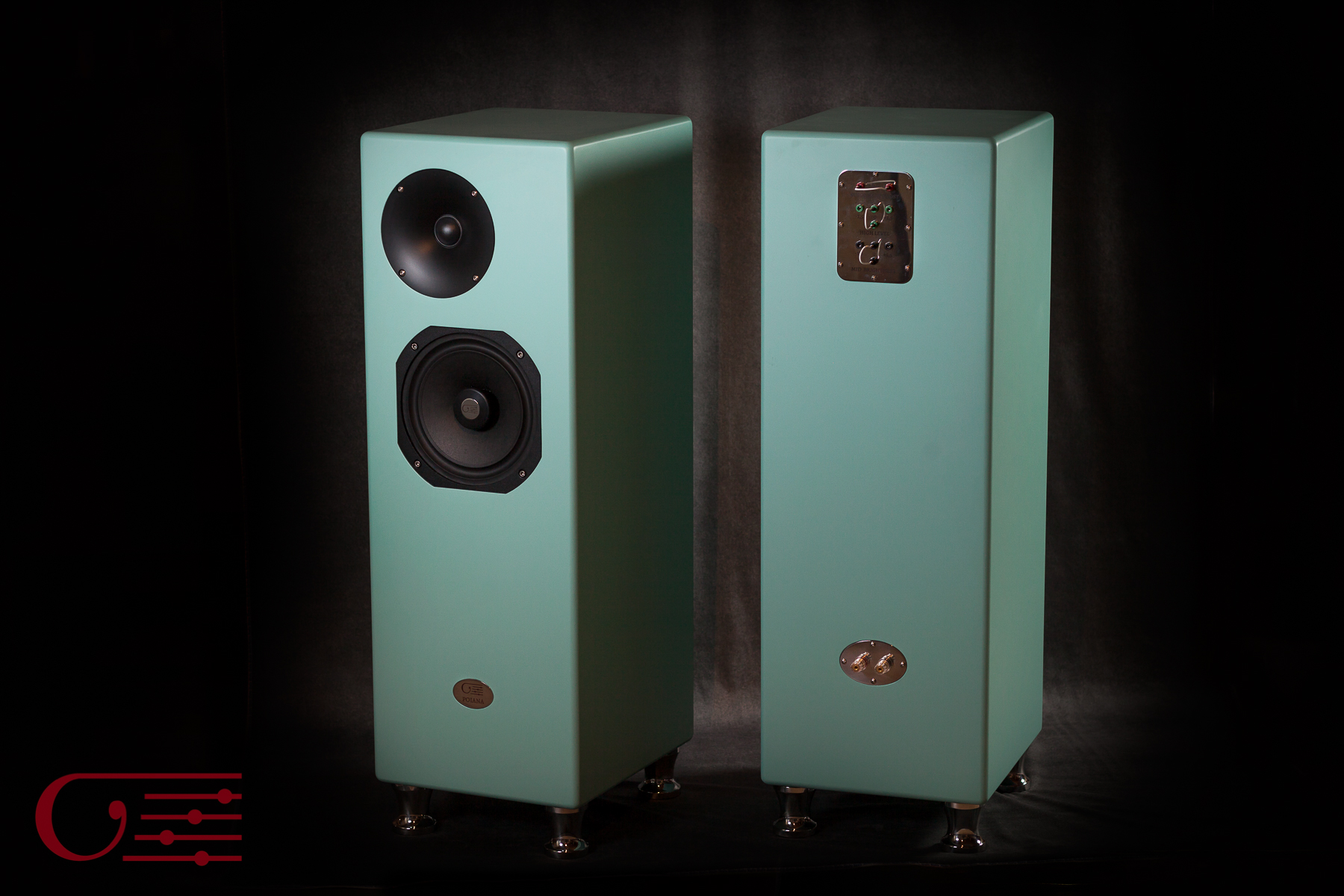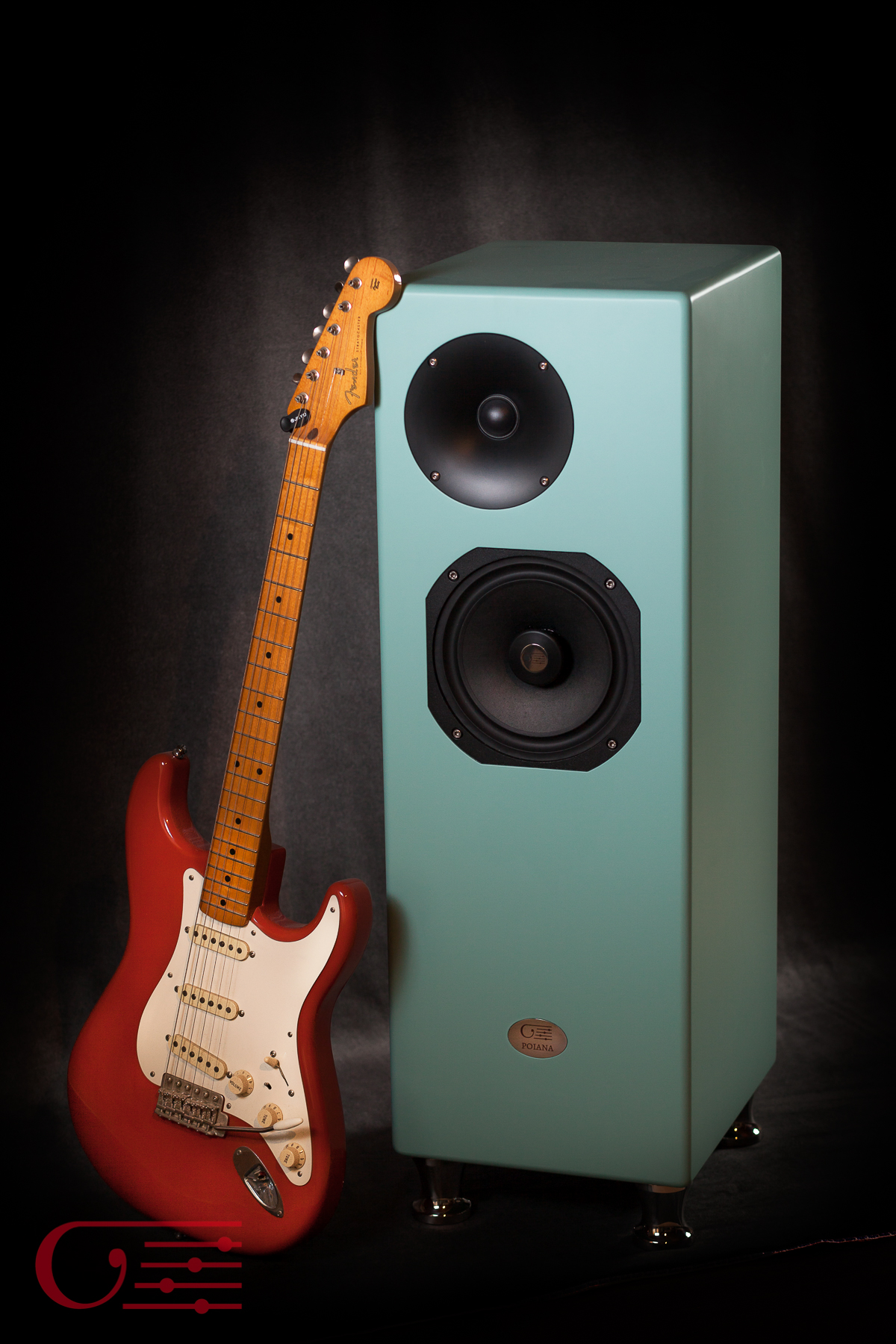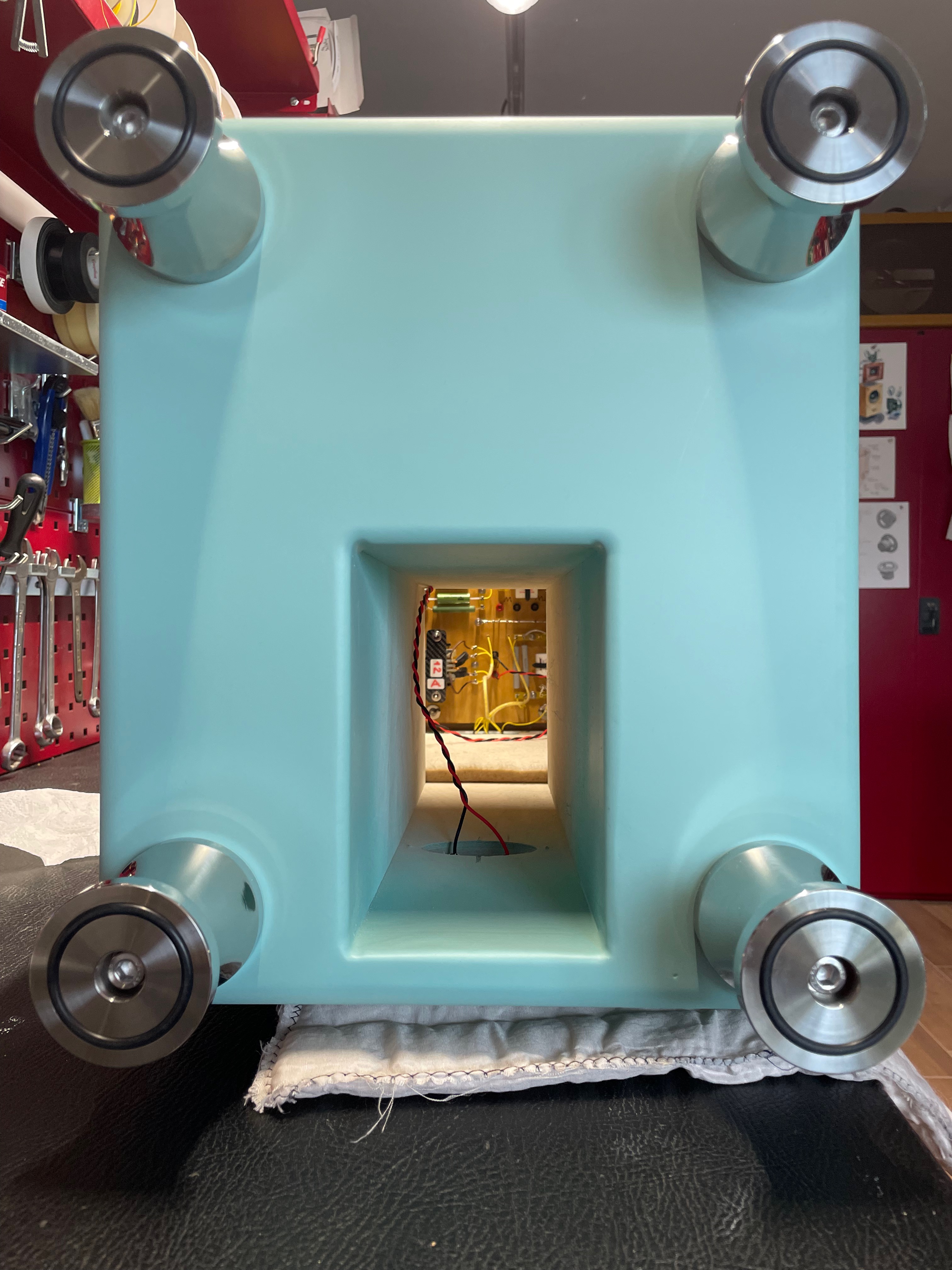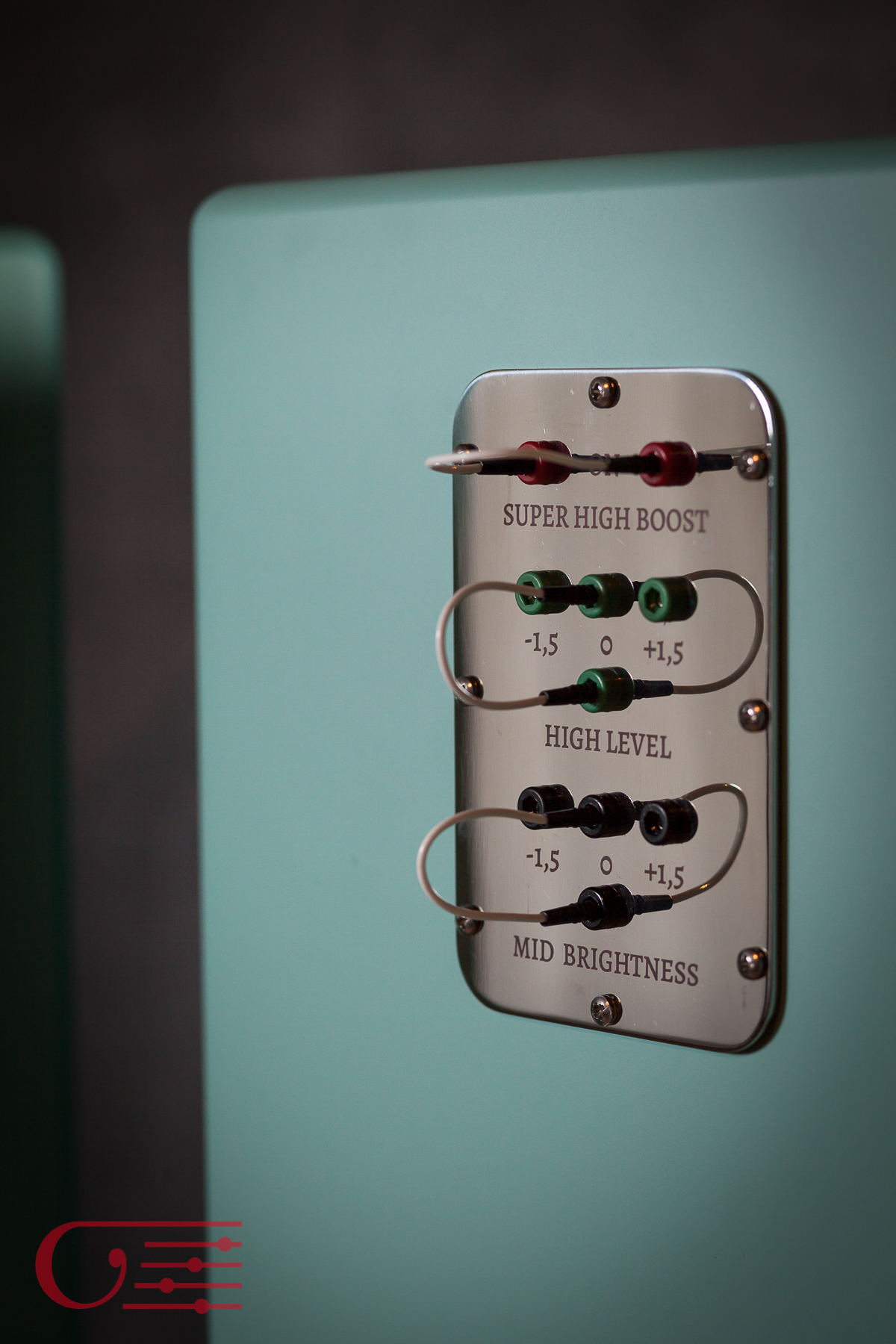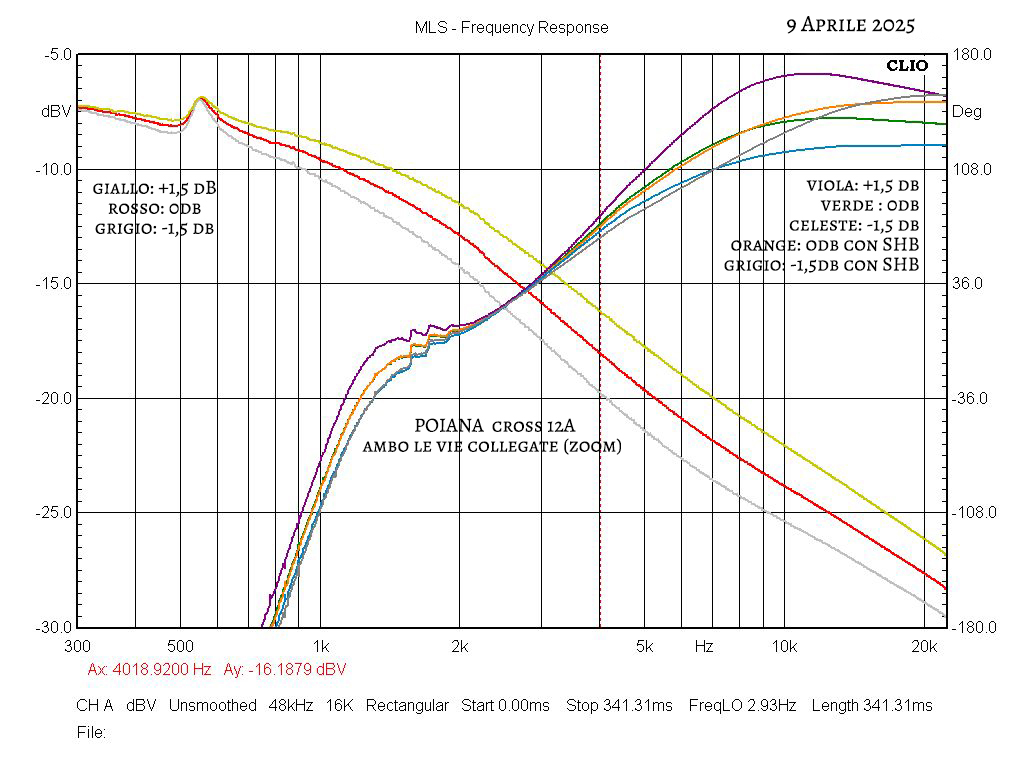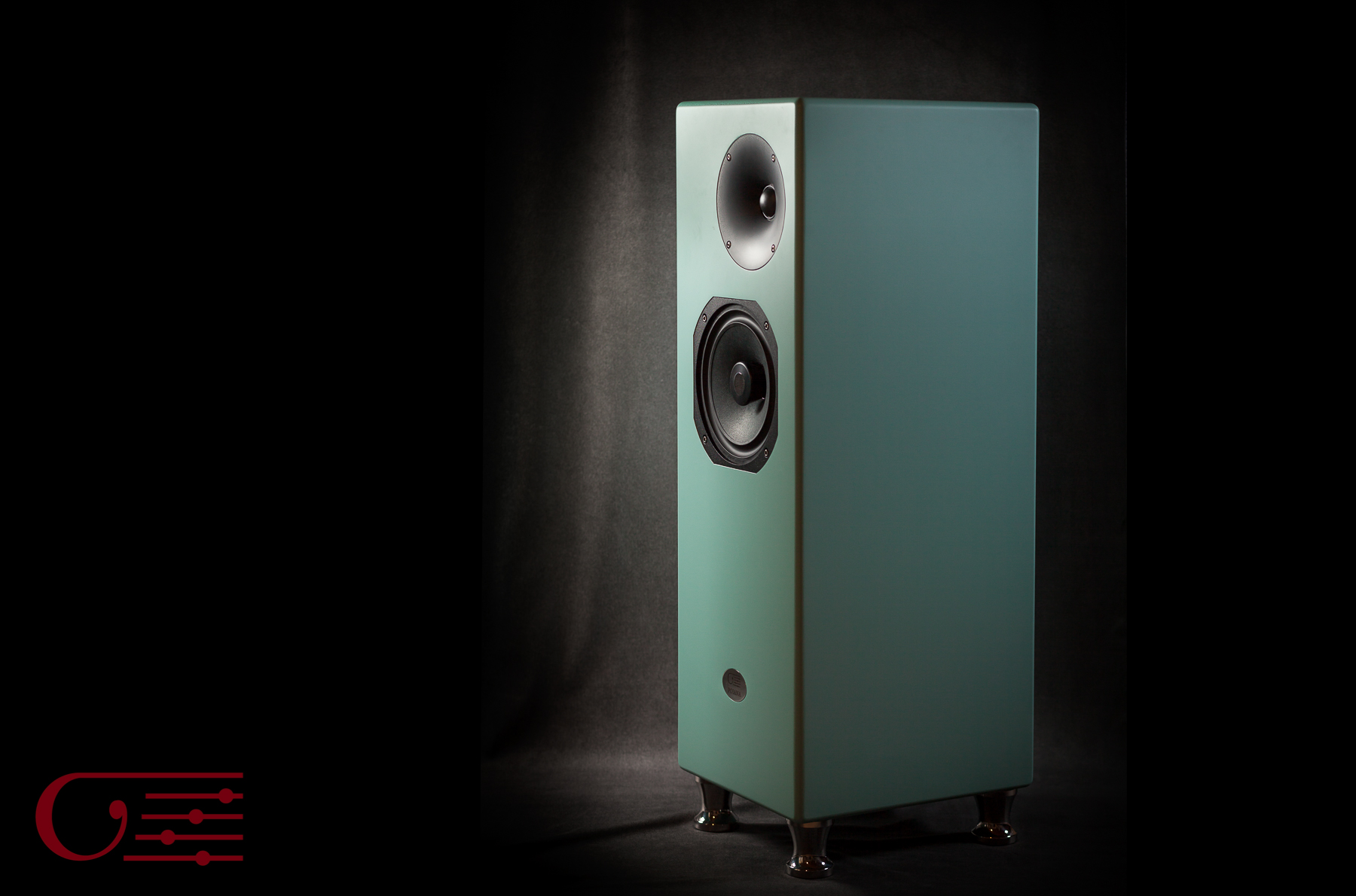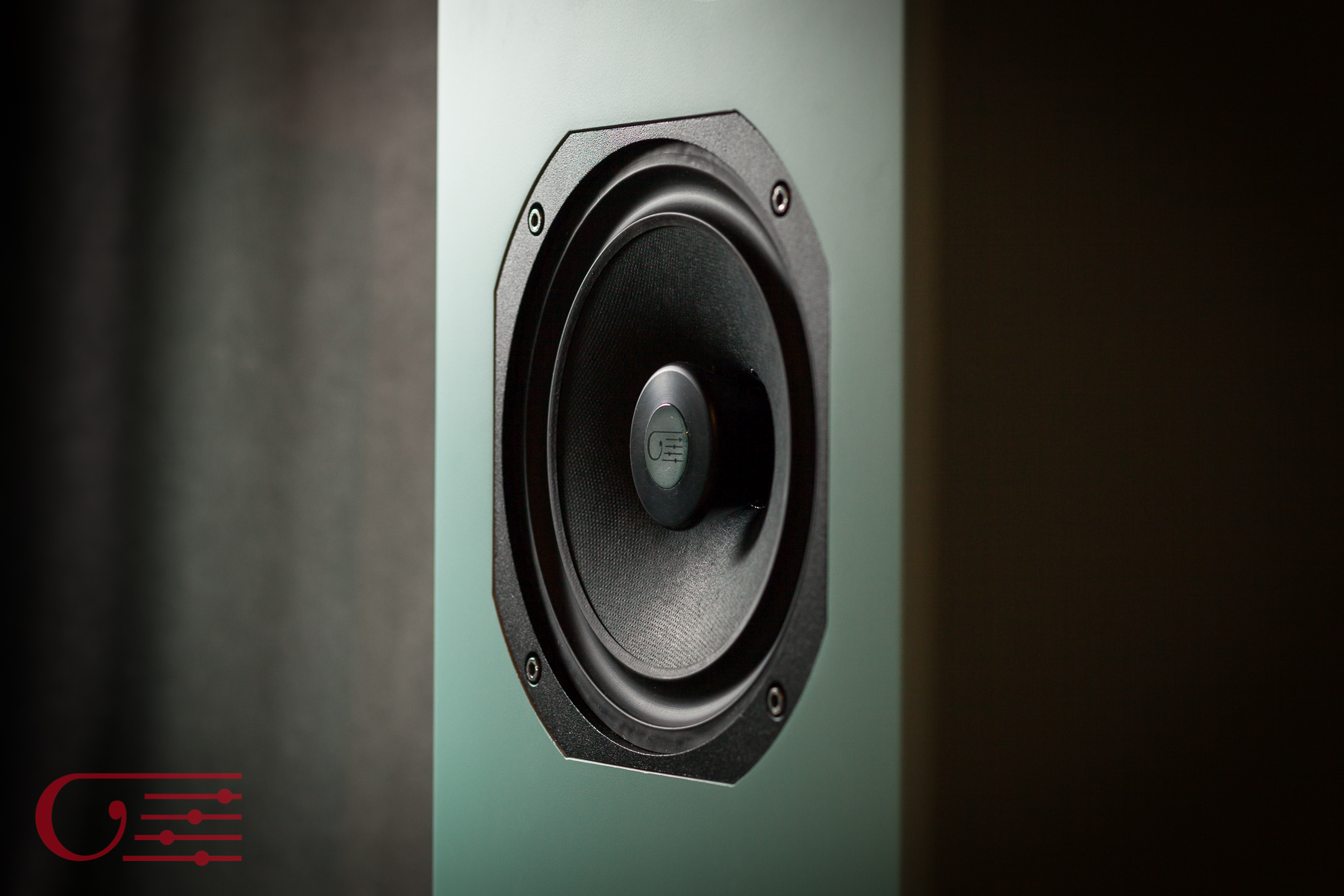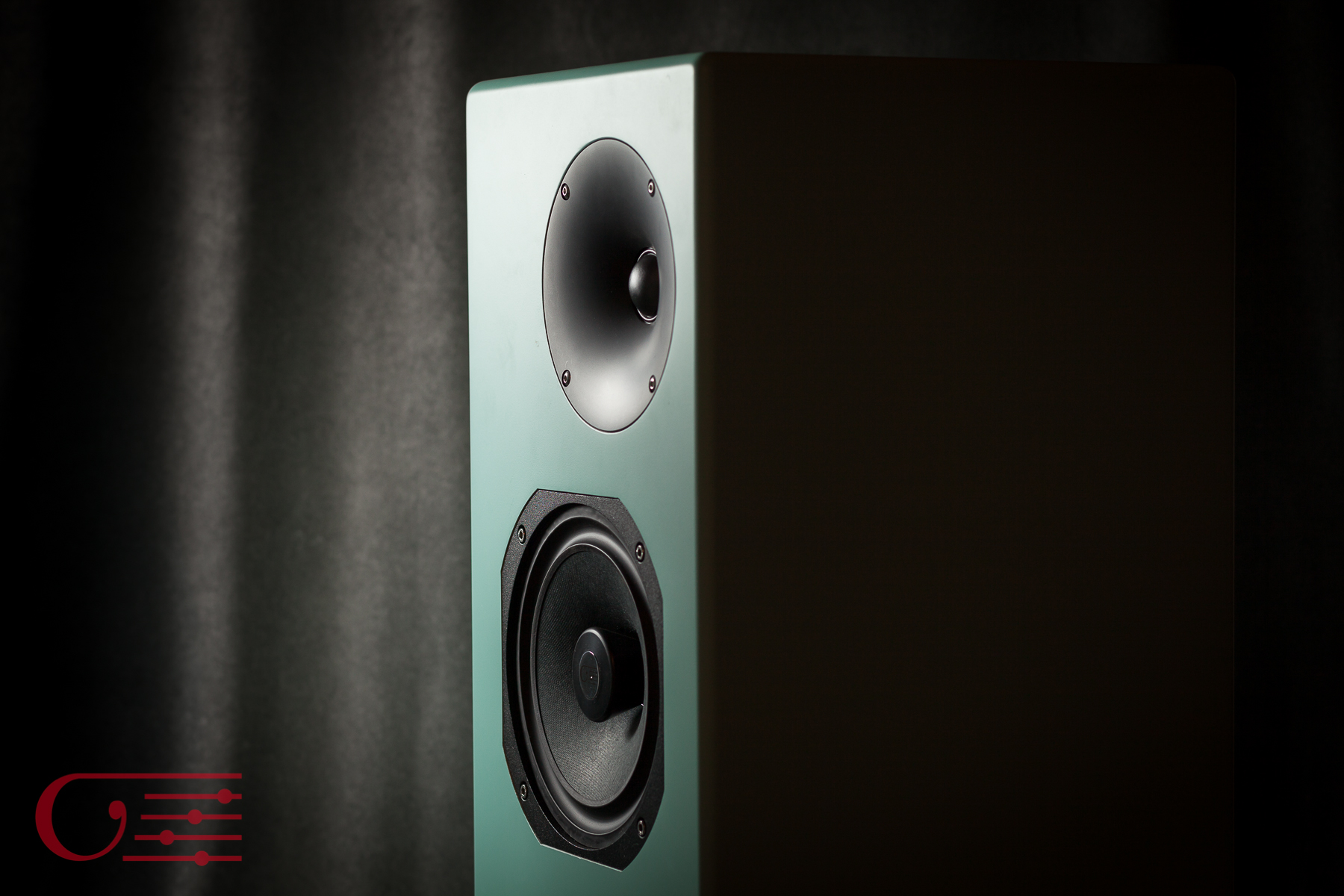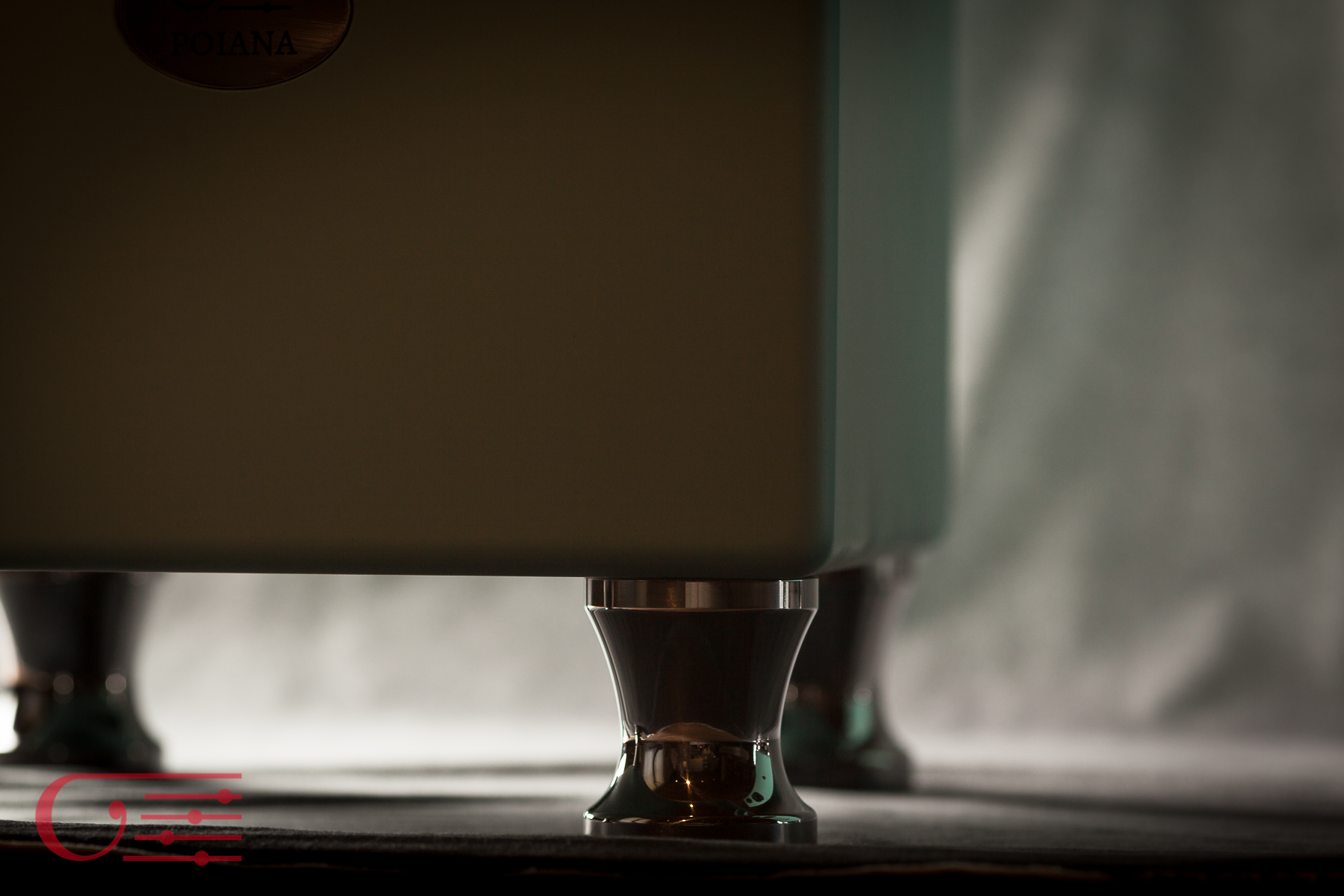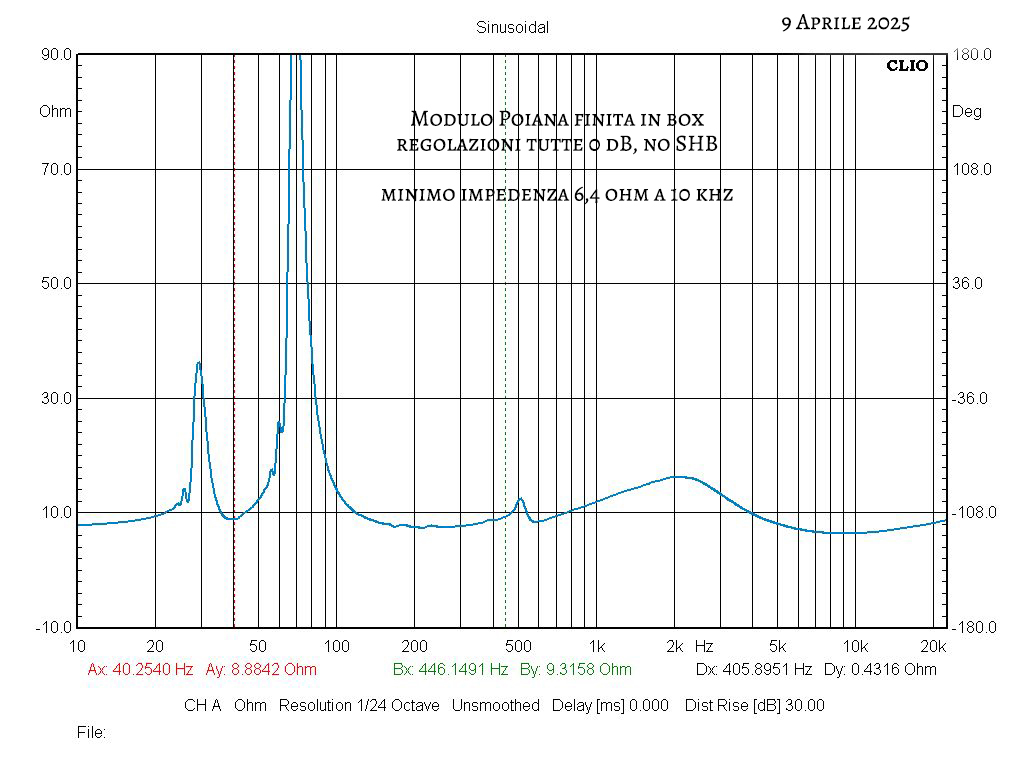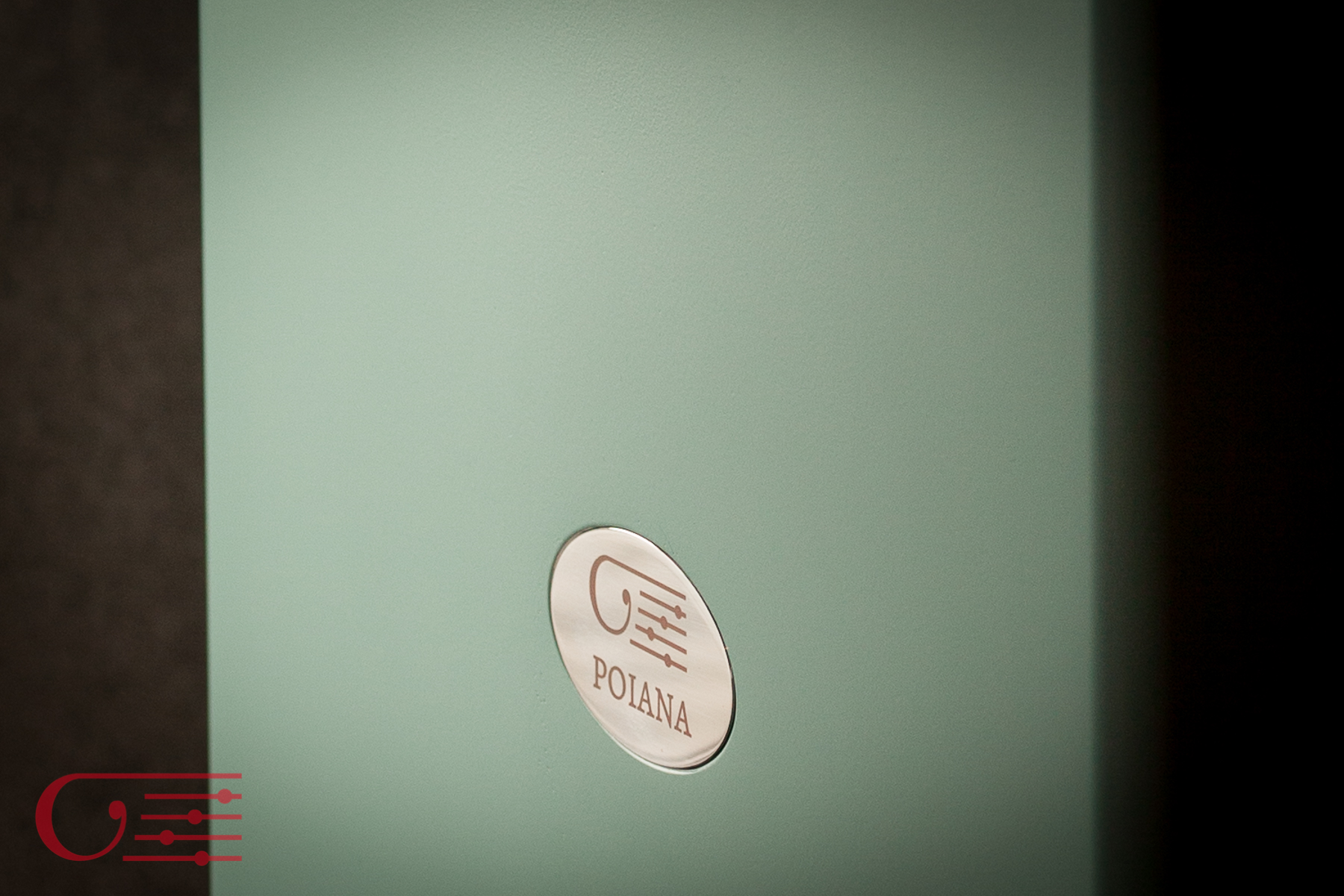Home |
Clinamen | Philosophy | Customer reviews | White paper | Pricing policy | Contact


"POIANA" 8" two-way floor-standing
April 16, 2024
Identity card
Poiana is a two-way floor-standing speaker, featuring a custom 8” EMS woofer in a proprietary down-fire reflex enclosure, and a soft dome Seas Excel series tweeter of 1.5” modified to operate in a giant waveguide.
The name
First of all, I will justify the name, which is quite special. During the weeks of prototype development, which took place between late September 2024 and January 2025, there were several hawks soaring outside my workshop/studio (located on a beautiful hill in Italy at 220 meters above sea level on the border between Marche and Abruzzo). I enjoyed watching the hawks take advantage of thermals (rising warm air currents) to gain altitude during my breaks, overcoming gravity by moving in a series of helical circles within them. I loved watching and listening to their characteristic calls. Feeling inspired by so much wonder, I chose “Poiana” (Hawk) as the name for this project.
A highly technological speaker but for all audiophiles (very high WAF index)
Poiana was born with foundational design principles aimed at introducing the quality and the philosophy of Clinamen to a more diverse and extensive audiophile audience than the one I usually address.
The shapes of the Poiana are classic and elegant, with a column just under one meter tall, slender and supported by four sinuous stainless steel feet polished to a mirror finish. The overall dimensions are manageable in any home environment. The actual size appears even smaller thanks to the rounded edges with a wide radius, and the satin-effect green copper paint finish.
The Poiana, together with a Fender Stratocaster, highlight its modest dimensions
This classicity and the docility of the aesthetic design conceal beneath the surface the design DNA of Clinamen.
In fact, whenever I design an electroacoustic transducer (as the term indicates, it is a device that accepts an electrical signal at its input and transforms it into an acoustic signal through a conversion efficiency), I strive to achieve maximum transduction efficiency, compatible with the diameter of the speakers used. I have achieved a value of 93 dB/W/m, making the Poiana suitable for amplifiers between 5 and 10 watts RMS with zero feedback tube amplification.
The Poiana are designed for rooms from small to medium-large, approximately from 10 to 25/30 square meters. In this range, they deliver the best performance and balance, with a great tonal harmony and emotional engagement.
Always to make the Poiana accessible from all angles, I thought of designing them with a proprietary down-fire reflex port based on the golden ratio: the term 'down-fire' tells us that the reflex port radiates downward towards the floor. This offers many important advantages:
- First of all, the low frequency range is strengthened because the solid angle of radiation is half of what is usually achieved with a front or rear-facing duct.
- The midrange frequency, which always slightly exits from the reflex port (temporarily delayed and full of distortions caused by multiple reflections), is cut off by reflection on the floor and cannot reach our ears.
- There is the possibility to position the Poiana speakers anywhere in the house, even close to the wall, without compromising the performance of the bass range
The advantages of the Clinamen down-fire bass tuning system are indeed quite significant. If anyone is wondering whether the low-frequency range reproduced by the Poiana could be redundant or monotonous due to its proximity to the floor, I can assure you that nothing could be further from the truth. In fact, the tuning section of the Poiana's reflex duct is GOLDEN, with a surface area nearly equal to the Sd surface of the woofer! The clarity, speed, and articulation of this proprietary Clinamen tuning are unmatched by any standard reflex enclosure.
Additionally, to cater to the preferences of a wide range of enthusiasts, I have incorporated three adjustable levels into the crossover. These tuning options allow for fine-tuning the speaker's tonal balance to suit various listening environments (the reflectivity index of listening rooms is uncertain and highly variable). Last but not least, the ability for enthusiasts to perform fine adjustments on the crossover aligns with their personal and subjective preferences.
So, a crossover for all needs
I would like to discuss the appropriateness and methods of adjustments that can be made to the crossover. The first point to emphasize is that, regardless of the adjustments performed, it is not possible to fundamentally alter the speaker; doing so would go against sound engineering principles. The user can only "personalize" the final result because, as I repeat, the surrounding conditions (such as room reflectivity and subjective preferences of the enthusiast) can vary.
Having made this necessary clarification, the tuning adjustments for the emission levels are carried out by manually moving jumpers on a series of sockets located on an elegant, mirror-polished stainless steel rear panel. I rarely use rotary switches; I prefer to use jumpers with 2 mm plugs, which I consider more reliable and less prone to deterioration over time.
SERVICE NOTE: The two jumpers, MID BRIGHTNESS and HIGH LEVEL, must always be inserted; otherwise, the woofer and the tweeter would not be connected, and no sound would be emitted.
The macro bands within which adjustments are possible are three:
- Midrange Brightness: This adjustment operates within the frequency range of 500 Hz to 2 kHz. It has three adjustable positions, spaced 1.5 dB apart.
- Treble Level: This adjustment affects the frequency range of 3.5 kHz to 10 kHz. Similar to the previous, it offers three regulation levels, each spaced 1.5 dB apart.
- Super High Boost (SHB): This adjustment has a single position—either active or inactive. Activation is achieved by inserting a jumper. The SHB operates above 10 kHz and provides approximately a 1.5 dB gain in these frequencies. It is important to note that the SHB functions only when the treble level is set to 0 dB or -1.5 dB. In other words, the SHB does not work when the treble level is adjusted to +1.5 dB.
The elegant AISI 304 panel for adjusting the speaker emission levels
Electrical response of the cross finished on the speakers, for the various adjustment levels
In fact, the SHB operates by effectively eliminating the attenuation introduced to the tweeter above 10 kHz. This is only achievable if the tweeter is attenuated. The energy recovery above 10 kHz, which the SHB provides, can be beneficial in certain listening scenarios, especially considering that in the Poiana model, the tweeter is a dome significantly larger than typically used. This design choice allows for a very low crossover point, ensuring high coherence. However, the downside is a slight attenuation of the very high frequencies, beyond approximately 12-13 kHz.
The speakers
The woofer is an 8-inch component manufactured by EMS in France, customized according to the specific requirements of the Poiana. The 38 mm voice coil, wound on a Kapton former, moves within a narrow magnetic gap capable of generating a force factor close to 10 Tesla per meter. This design imparts a high acceleration factor to the lightweight paper cone. The speaker's elastic elements (the spider and rubber suspension), which have relatively low compliance, are intentionally designed to quickly return the woofer to its resting position. The low-frequency range provided by such a woofer, implemented in the Poiana's Clinamen crossover, is extremely fast and free of resonant tails.
The frame is made of die-cast aluminum and is flush-mounted onto the 24 mm thick birch plywood enclosure. Finally, the woofer does not feature the typical central dust cap but instead has a functional phase plug with a proprietary mushroom-shaped profile machined in Derlin. This component not only optimizes dispersion at the crossover point but also plays an important role in controlling certain break-up modes of the cone.
The tweeter is a refined Seas Excel with a 1.5-inch soft dome membrane, equipped with a neodymium magnet and a rear chamber to lower its resonance frequency (Fs) and enable use at very low frequencies. It is then modified by removing the original front flange and replacing it with a giant Delrin waveguide, designed to optimize dispersion and coherence at the acoustic crossover with the woofer. This setup allows for a very low crossover point, around 1400 Hz. Therefore, choosing a tweeter with an oversized 1.5-inch (38 mm) dome and rear chamber perfectly matches the adopted acoustic crossover frequency.
The tweeter is mounted asymmetrically relative to the longitudinal symmetry axis of the loudspeaker front panel. This is done both to avoid the accumulation of diffractive effects at the edges of the baffle and to offer two possible placement options in the environment: internal or external tweeter positioning. The acoustic scene and the imaginary soundstage vary significantly between these two configurations, allowing the listener to select the optimal position based on personal preferences and the size of the listening space.
Detail of the Poiana speakers: notice the profiling of the tweeter's waveguide
Finally, I want to emphasize how the speakers and the stainless steel flanges of the input connectors and level adjustment plate use gaskets made from laser-cut 1mm thick flexoid paper. The advantages are both sonic and practical: in fact, regular rubber gaskets tend to stick to the speakers after many years, making disassembly very difficult.
Various techniques
The Poiana cabinet is made from 24 mm birch plywood, assembled with 45-degree joints.
Inside, two different types of absorbent are used to effectively absorb the internal pressure waves. In the most critical points, real wool felt is employed. These precautions, combined with the golden ratio section tuning column of large cross-section, help minimize the stationary energy bouncing off the back of the woofer cone.
The down-fire tuning radiates toward the floor at a predetermined distance, defined by the four impressive Clinamen feet made of mirror-polished AISI 304 stainless steel, each weighing 1 kg. These feet not only precisely set the cabinet's designed Fb (tuning frequency), but also significantly lower the speaker's center of gravity, enhancing both the bass response and the stability of the speaker against potential impacts.
A final note on the crossover, this time regarding its construction. It is point to point wired on a 12mm birch plywood board, on which all components are individually fixed. The wiring uses silver-plated copper cable insulated with Teflon. The capacitors are Mundorf EVO OIL. The woofer coil is a small point of pride: I call it a zero-ohm flux coil, fully confined. It is a proprietary Clinamen component and partly responsible for the lightning-fast bass response of the Poiana. This coil features intermediate taps that interface with the system used to adjust the brightness level of the midrange. The crossover is secured with M5 screws onto wooden spacers, glued underneath the top panel of the speaker. The input cables and those running from the speakers to the crossover are terminated with 4mm banana plugs or bushings.
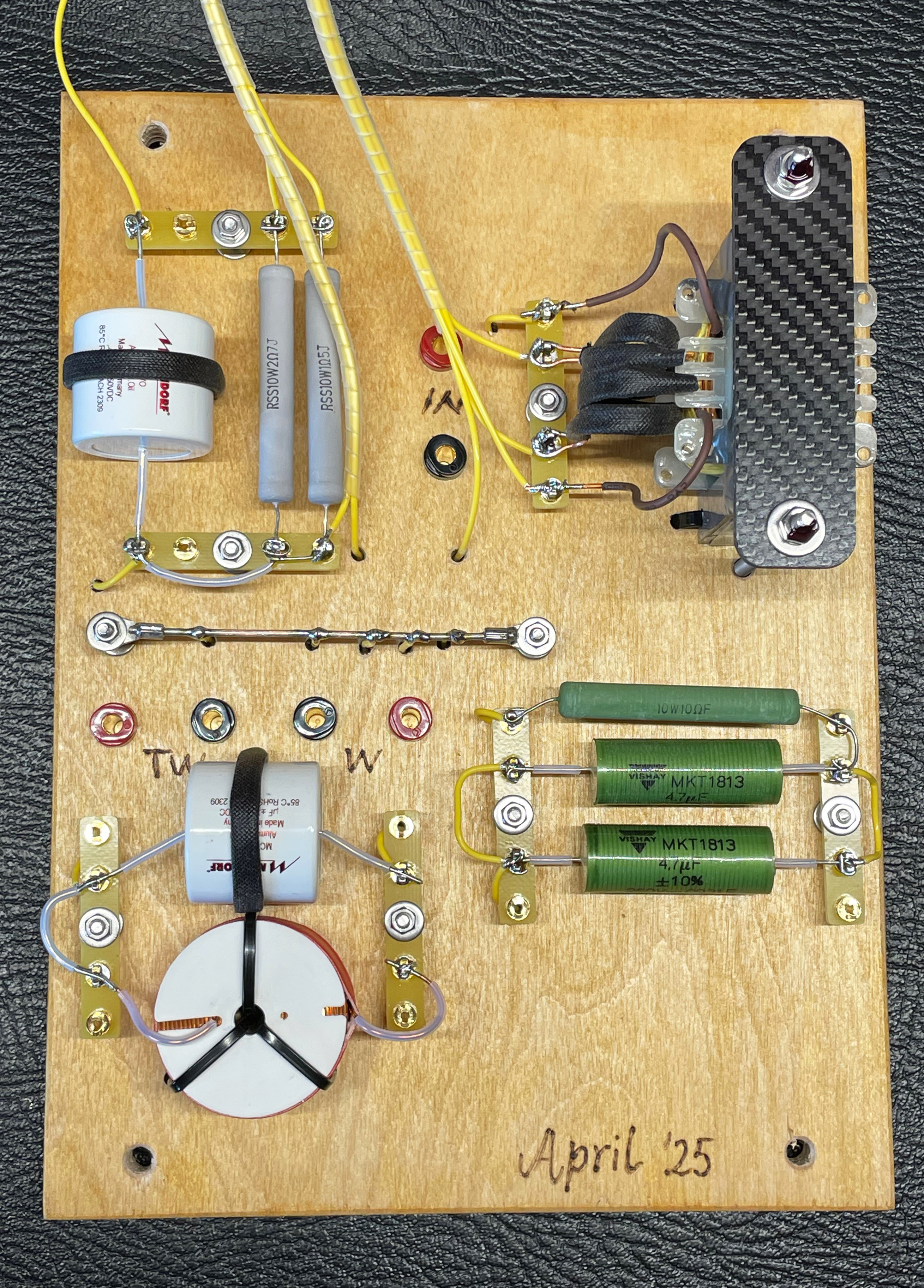
Therefore, the crossover unit can be easily detached from the speaker enclosure and drivers for inspection and potential maintenance (although I doubt any maintenance interventions on the crossover will be necessary within the next 40 years).
The internal wiring of the speakers and input terminals is made with Jantzen AWG16 silver-plated copper cable, Teflon-insulated, carefully twisted.
Usages notes
Poiana are designed to sound in medium-reflectivity home environments, between 10 and 30 square meters.
The woofer's tuning is crafted with the consideration that the amplifier driving them will have a non-negligible output impedance: we're talking about a speaker designed for zero-feedback tube amplifiers.
A zero-feedback amplifier, built for quality rather than quantity, will provide very enjoyable listening hours with the Poiana. For satisfying listening levels, 5 watts RMS are already sufficient. Personally, I don't think it's necessary to exceed 10 watts, and I believe that maintaining high quality becomes impossible as power increases, regardless of the amplifier's cost (that's my opinion, and I certainly don't claim it's a rule).
The impedance module of the speaker is extremely gentle and remains at very high levels. Just think that the minimum impedance value of 6.4 ohms is reached at around 10 kHz. Therefore, the Poiana, much like the hawks soaring using thermal currents, is a light and not very demanding load for small-power tube amplifiers (for which they are designed).
Speaker impedance module; note the resonance at 40 Hz and how the impedance remains above 6.5 ohms throughout
Finally, I recommend a burn-in period of at least 50-100 hours to allow the speakers to reach almost their full potential.
You can watch a video of the Poiana in action with the Lumina and the Clinamen CL12 turntable on the Clinamen YouTube channel (which I suggest you subscribe to in order to stay updated on their content).
Poiana logo in AISI 304 laser-engraved, subtle touch
Poiana Data sheet
- Two-floor-standing speakers with proprietary Golden Ratio Reflex Downfire enclosure
- Custom EMS 8" woofer with Clinamen mushroom-shaped Delrin phase plug,
- SEAS 1.5" tweeter mounted on a giant Delrin waveguide.
- Crossover with proprietary Clinamen zero-ohm inductor featuring confined flux and attenuation controls. Acoustic crossover frequency: 1350 Hz.
- Multiple adjustments: midrange brightness, tweeter level, super high boost (SHB) via jumpers on the rear panel.
- Internal twisted wiring with AWG 16 silver-plated Teflon-insulated copper cable (Jantzen).
- Cabinet made from 24 mm multilayer birch plywood.
- Clinamen feet in AISI 304 stainless steel, each weighing 1 kg, mirror-polished.
- Matte satin finish lacquer in copper green color.
- Sensitivity: 93 dB/W/m.
- Dimensions: 36 x 31 x 94 cm (including AISI 304 feet).
- Net weight per speaker: 30 kg.
- Recommended room size: from 10 to 25 m².
- Selling price: €9,200 per pair.

